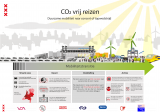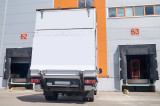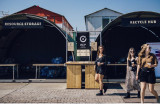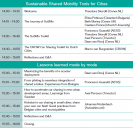Stay in the know on all smart updates of your favorite topics.
Amsterdam Smart City tekent: samen maken we CO2 neutraal reizen naar evenementen de norm

Het klimaat verandert en het wordt steeds drukker in Amsterdam. Jaarlijks komen er alleen al miljoenen bezoekers op Zuidoost af voor het grootste entertainment gebied van Nederland. We staan voor de opgave om de stad, waaronder Zuidoost, leefbaar, veilig en tegelijkertijd bereikbaar te houden. Verschillende partners slaan daarom nu de handen ineen om bezoekers van en naar evenementen in 2023 CO2 neutraal te laten reizen
De auto is op dit moment het meest gebruikte vervoersmiddel in Zuidoost. Amsterdam heeft ervoor gekozen om de privé auto minder ruimte te geven in de stad en de uitstoot van fossiele brandstof terug te dringen om de luchtkwaliteit in de stad te verbeteren en bij te dragen aan de klimaatdoelstellingen.
De transitie van mobiliteit vraagt om een samenwerking tussen (semi) publieke en private partijen en het verstevigen van duurzame alternatieven voor de privé auto. Op 11 mei hebben de gemeente Amsterdam, Johan Cruijff ArenA, Ajax, NS, GVB, Transdev, VRA en Amsterdam Smart City getekend voor een samenwerking rondom CO2 neutraal reizen. Het doel: in 2023 bezoekers CO2 neutraal te laten reizen van en naar één of meerdere evenementen in de Johan Cruijff ArenA. Zodat we samen leren hoe we CO2 neutraal reizen naar evenementen de norm maken
Op de Amsterdam Smart City Demodag op 14 juni zullen de bovenstaande organisaties bij elkaar komen in één van de werksessies, om verder na te denken over het proces. Wat hebben we nodig? Wat wordt de werkwijze? Wat kunnen de grootste hobbels zijn?
Ben je werkzaam bij één van onze partnerorganisaties en lijkt het je interessant om hierover mee te denken? Stuur een mail naar trisha@amsterdamsmartcity.com voor verdere informatie over deelname aan de werksessie.
METROPOLITAN MOBILITY CONFERENCE: Building hubs for sustainable and liveable cities

eHUBS are starting to play an important part in the development of sustainable and liveable cities. As the shift to more sustainable transport becomes increasingly urgent, we must develop services which provide a real last-mile alternatives to the private passenger car. This is where eHUBS come in. An eHUB is an on-street location where electric shared mobility services, from escooters, to ebikes and cargo bikes can be found and used. These mobility hubs have the potential to significantly change the future of urban mobility, creating accessible, affordable and centralised shared mobility services. In this conference, we share experiences and exchange ideas about the current use and future of eHUBS.
The conference will explore the role of eHUBS, the lessons learned from cities pioneering them and opportunities for the future found by universities. Across two days, we hear from local authorities, universities, and mobility experts, sharing knowledge and inspiring their peers.
Several European cities are already experimenting with eHUBS, piloting the concept to create cleaner, sustainable and livable cities. This eHUBs conference is a result from the eHUBS project, which is funded by the Interreg NWE Programme, with six partner cities from five countries implementing the shared mobility concept, paving the way for others to do the same.
Free admission
22. Two '100 smart city missions'- Twice an ill-advised leap forward

The 22nd and penultimate episode in the *Better cities: The contribution of digital technology-*series will discuss two ambitious ‘smart city’plans of two governments and the associated risks.
Recently, the European Commission launched a 100-city plan, the EU Mission on Climate-Neutral and Smart Cities. One hundred European cities that aspire to be climate neutral by 2030 (you read that correctly) can register and count on supplemental funding. I immediately thought of another 100-city plan, India's Smart City Mission. In 2015, Prime Minister Modi announced that in six years 100 Indian cities would become 'smart'. The official term of the project has now ended, and I will examine below whether this goal has been achieved, I discuss the two plans and then explain why I call both of them a leap forward. At the end I will make a few suggestions for how the European mission can still learn from the Indian one.
India's Smart City Mission
The problem
In India, 377 million people live in cities. In 15 years, 200 million will have been added. Already, traffic in Indian cities has come to a complete standstill, each year more than 600,000 people die from air pollution, half of the urban areas have no drinking water connection, waste collection is poor and only 3% of sewage is treated. The rest is discharged into surface water, which is also the main source of drinking water.
The mission
The Smart City Mission was intended to implement substantial improvements on all these problems in 100 cities, which together comprise 30% of the population. In the improvements digital technology had to play an important role.
The 100 cities were selected because of favorable prospects and the quality of the plans, which usually consisted of a long series of projects.
Governance
The regular city governing bodies were deemed incompetent to lead the projects. That is why management boards (‘special purpose vehicles’) have been appointed, operating under company law and led by a CEO, supported by international consultancy firms. All rights and duties of the City Council regarding the execution of the mission were delegated to the appointed boards, including the power to collect taxes! Not surprisingly, this decision has been challenged in many places. Several cities have withdrawn from 'the mission' for this reason.
Financing
To implement their projects, each city would receive $150 million over five consecutive years. This money should be seen as seed capital to be supplemented from additional sources such as public-private partnerships, commercial bank lending, external financing, loans, and foreign investment.
Area-oriented and pan-urban approach
The plans contain two components: an area-oriented and a pan-urban approach. The first aims at adapting, retrofitting or new construction and should relate to a wide range of 'smart services'. For example high-speed internet, waste facilities, parking facilities, energy-efficient buildings, but also replacement of slums by high-rise buildings. The slick 'architectural impressions' that circulated at the beginning of the planning period (see above) mainly concern the area-oriented approach.
The pan-urban approach includes at least one 'smart' facility for a larger part of the city. The choice is often made to improve the transport infrastructure, for example the construction of new roads and highways and the purchase of electric buses. No fewer than 70 cities have built a 'smart' control center based on the example of Rio de Janeiro, which I believe was rather premature.
Progress
Now that the official term of 'the mission' has ended, a first inventory can be made, although observers complain about a lack of transparency about the results. About half of all the 5000 projects that have been started have not (yet) been completed and a significant part of the government funds have not yet been disbursed. This could still happen in the coming years. This is also because attracting external resources has lagged behind expectations. These funds came mainly from governments, and large technology companies. This has had an impact on the implementation of the plans.
The slow progress of most projects is partly because most of the population was barely aware of the mission and that city councils were not always cooperative either.
Impact
It was foreseen that half of the available resources would go to area-oriented projects; this eventually became 75-80%. As a result, on average only 4% of the inhabitants of the cities involved have benefited from 'the mission' and even then it is not clear what the benefits exactly entail. The city of New Delhi covers an area of almost 1500 km2, while the area concerned is only 2.2 km2: So you're not even going to have 100 smart cities. You're going to have 100 smart enclaves within cities around the country, said Shivani Chaudhry, director of the Housing and Land Rights Network.
It soon became clear that the mission would be no more than a drop in the ocean. Instead of $150 million, it would take $10 billion per city, $1000 billion in total, to address all ambitions, according to an official calculation. Deloitte was a little more modest, calculating the need for $150 billion in public money and $120 billion from private sources.
Type of projects
The many topics eligible for funding have resulted in a wide variety of projects. Only one city has put the quality of the environment first. Most cities have initiated projects in the areas of clean energy, improving electricity supply, reducing air pollution, construction of new roads, purchasing electric buses, waste disposal and sanitation. What is also lacking, is a focus on human rights, gender, and the interests of the poorest population groups.
In some places, it has been decided to clear slums and relocate residents to high-rise buildings on the outskirts of the city. Indian master architect Doshi warns that the urban vision behind the smart city plans will destroy the informality and diversity that is the cornerstone of the country's rural and urban society. He challenges planners to shift the emphasis to rural areas and to create sufficient choices and opportunities there.
The European Mission on Climate-neutral and Smart Cities
The problem
Cities produce more than 70% of the world's greenhouse gas emissions and use more than 65% of total energy. In addition, cities in Europe only cover 4% of the total surface area and accommodate 75% of the population. The ecological footprint of the urban population is more than twice what it is entitled to, assuming a proportional distribution of the earth's resources.
The mission
On November 25, 2021, the European Commission called on European cities to express their interest in a new European mission on Climate-neutral and smart cities. The mission aims to have 100 climate-neutral and smart cities by 2030, which will act as a model for all other European cities.
The sectors involved in this transformation process are the built environment, energy production and distribution, transport, waste management, industrial processes and product use, agriculture, forestry, and other land uses and large-scale deployment of digital technology. That is why the European Commission talks of a green and digital twin, or a simultaneous green and digital transformation.
Governance
Reaching the stated goal requires a new way of working and the participation of the urban population, hence the motto 100 climate neutral cities by 2030 - by and for the citizens.
According to the plan's authors, the main obstacle to climate transition is not a lack of climate-friendly and smart technology, but the inability to implement it. The current fragmented form of governance cannot bring about an ambitious climate transition. Crucial to the success of the mission is the involvement of citizens in their various roles as political actors, users, producers, consumers, or owners of buildings and means of transport.
Funding
The additional investment to achieve the mission is estimated at €96 billion for 100 European cities by 2030, with a net positive economic benefit to society of €25 billion that will increase further in the period thereafter. The European Commission will provide €360 million in seed funding.
The overwhelming amount of funding will have to come from banks, private equity, institutional investors, and from the public sector at the local, regional and national level.
What went wrong with the Indian Mission and its follow-up
The gap between ambitions and reality
Almost all comments on 'the mission' emphasize that three necessary conditions were not met from the start, namely a widely accepted governance model, adequate funding, and involvement of the population and local government. There was an unbridgeable gap between ambitions and available resources, with the contribution of external capital being grossly overestimated.
The biggest problem, however, is the gap between the mission's ambitions and the nature of the problems that India it faces: Cities are bursting at the seams because of the millions of poor people who flock to cities every year in search of work and a place to live that find them only in the growing slums. The priorities for which the country must find a solution are therefore: improving life in rural areas, improving housing in the cities, ensuring safe drinking water, waste disposal, sanitation, and purification of wastewater, good (bus) transport and less polluting car traffic. Urgently needed is a sustainable development model that addresses ecological problems, makes urbanization manageable, controls pollution and will use resources efficiently.
Leap forward
The 'Mission' is a leap forward, which does not tackle these problems at the root, but instead seeks a solution in 'smartification'. Policymakers were captivated by the promises made by IBM and other technology companies that ICT is the basis for solving most urban problems. A view that I objected in the third episode of this series. IC solutions have been concentrated in enclaves where businesses and prosperous citizens are welcomed. The Government of India Special Rapporteur on Housing therefore notes that the proposals submitted had a predominant focus on technology rather than prioritizing affordable housing and doubts the correctness of this choice.
Instead of emphasizing the role of digital technology, the focus should have been on equitable, inclusive, and sustainable living areas for all. Not the area-oriented but the pan-urban approach should have prevailed.
Follow-up
Several authors suggest future actions consistent with the above comments:
• Setting a longer time horizon, which is much more in line with the problems as they are felt locally.
• Decentralization, coupled with strengthening local government in combination with citizen participation.
• A more limited number of large-scale pan-urban projects. These projects should have an immediate impact on all 4000 Indian cities and the surrounding countryside.
• More attention for nature and the environment instead of cutting down trees to widen motorways.
• Training programs in the field of urbanization, partly to align urban development with Indian culture.
The European mission revisited
Leap forward
Europe and India are incomparable in many ways, but I do see similarities between the two missions.
With the proclamation of the 'mission', the Indian government wanted to show the ultimate – perhaps desperate – act of determination to confront the country's overwhelming problems. I therefore called this mission a flight forward in which the image of the 'smart city' was used as a catalyst. However, the country’s problems are out of proportion to this, and the other means employed.
It is plausible that the European Union Commission also wanted to take an ultimate act. After the publication of the ambitious European Green Deal, each national governments seems to be drawing its own plan. The ‘100 cities mission’ is perhaps intended as a 'booster', but here too the feasibility of this strategy is doubtful.
Smart and green
The European Union cherishes the image of a 'green and digital twin', a simultaneous green and digital transformation. Both the Government of India and the European Commission consider digital technology an integral part of developing climate neutral cities. I hope to have made it clear in the previous 21 episodes of this series that digital technology will certainly contribute. However, the reduction of greenhouse gases and digitization should not be seen as an extension of each other. Making a city climate neutral requires way more than (digital) technology. Moreover, suitable technology is still partly under development. It is often forgotten that technology is one of the causes of global warming. Using the image of green and smart twins will fuel the tension between the two, just like it happened in India. In that case, it remains to be seen where the priority will lie. In India it was 'smart'.
Funding
Funding of the Indian mission fell short; much is still unclear about funding of the European mission. It is highly questionable whether European states, already faced with strong opposition to the costs of 'climate', will be willing to channel extra resources to cities.
Governance
The European mission wants to be by and for the citizens. But the goal has already been established, namely becoming climate neutral by 2030. A new 'bottom-up' governmental approach would have been to investigate whether there are cities where a sufficiently large part of the population agrees with becoming climate neutral earlier than in 2050 and how much sooner that could be and next, leave it to these cities themselves to figure-out how to do this.
Can Europe still prevent its mission from failing like India's? I propose to look for in the same direction as India seems to be doing now:
• Opt for one unambiguous goal: Reducing greenhouse gases significantly earlier than 2050.
• Challenge a limited number of cities each to form a broad coalition of local stakeholders that share this ambition.
• Make extra resources available, but also ask the cities themselves to make part of the necessary investments.
• Stimulate universities and industry to provide a European response to Big Tech and to make connections with the 'European Green Deal'.
My e-book Smart City Tales contains several descriptions of intended and alleged smart cities, including the much-discussed Saudi Arabian Neom. The Dutch version is here.
Replacing short car trips with LEV's may reduce CO2 emissions, study suggests

Smart mobility and LEV’s: a general introduction
#Smart-Mobility is an important aspect for daily life and commuting/recurrent transportation needs and in this day&age there are many potential solution(s) for smart-mobility in Amsterdam. Today some of these new vehicles types are mostly restricted on city streets and Amsterdam citizens cannot grasp the potential of this vehicles. These devices can go up to at least 20km of range for short trips and with vehicle speeds ranging from 20, 25, 45 km/h (e-scooter, e-bike, moped respectively) and some as far as 90km/h (micro-car 90), etc.
Potential CO2 emission reduction research
There is a study regarding CO2 potential emission reduction by the use of light electric vehicles (LEV's) in contrast to short car trips usage. LEV's CO2 emissions is averaged at 24g CO2 eq/km compared with conventional vehicles (including EV's) averaged at 203g CO2 eq/km. The findings are quite relevant since it could reduce CO2 emissions as much as 44% = 57 million tones CO2 eq per year. The full study can be found at URL link below.
Proposal
If the Gemeente Amsterdam would lift the ban on LEV’s, this would be beneficial for Amsterdam citizens since they would have less noise (silent devices), cleaner air (by the study analysis) and maybe more fun alternative to ICE-scooters and cars.
Just Sustainability Transitions Course

Energy, food, mobility, finance – just about every global sector is expected to transform dramatically in the coming decades. So isn’t it time you create your own transition strategy?
Do you believe, like us, that sustainability and social justice are key to fundamental change? Then join ‘Just Sustainability Transitions’: a hands-on, six-month course that provides the tools and inspiration needed to facilitate change processes.
GDZES MRA Meetup #9: Laden op Bedrijventerreinen, hoe pak je dat aan?

Goed nieuws: steeds meer bedrijven gaan over op elektrisch rijden. Belangrijk, want alleen zo kom je als leverancier straks in Zaanstad, Haarlem, Almere en Amsterdam de stad nog in!
Ook op bedrijventerreinen zien we steeds meer elektrische bestel- en vrachtwagens rondrijden. In de toekomst zal circa 80% van de laadsessies plaatsvinden op deze bedrijventerreinen.
Hoe zorgen bedrijven samen voor voldoende en slimme laadpunten? Welke kansen liggen er in het zelf opwekken van stroom en het inzetten ervan voor eigen gebruik? Hoe organiseer je je als ondernemers op een bedrijventerrein om dit collectief aan te pakken? Wat is daarbij de rol van parkmanagers? En wat mag je van de overheid verwachten?
Kom op 14 april van 15.30 tot 17.00 uur naar de GDZESMRA Meetup #9: Laden op Bedrijventerreinen, hoe pak je dat aan? Praat onder leiding van Richard Hoving, Lead Mobiliteit van de Amsterdam Economic Board, mee en doe inspiratie op om zelf toe te passen.
Programma
- Frans van der Beek (SADC) geeft inzicht in de regionale verduurzamingsopgave voor bedrijventerreinen waar realisatie van laadinfrastructuur onderdeel van uitmaakt.
- Dertje Meijer (Food Center Amsterdam) vertelt voor welke vragen en welke collectieve opgave het FCA staat om het laden op hun terrein slim te gaan regelen.
- Eric Beers (HCNP) laat zien welke kansen er liggen om als logistiek ondernemer zelf aan de slag te gaan en zelf stroom op te wekken voor eigen gebruik.
- Robert van den Hoed (NKL Nederland) geeft een preview van de handreiking laadpunten op bedrijventerreinen die in mei uitkomt.
- Maarten Linnenkamp (MRA Elektrisch) vertelt hoe zij ondertussen aan de slag zijn en ervaring opdoen met de realisatie van laadinfra en voertuigen op bedrijventerreinen.
Walther Ploos van Amstel (Hogeschool van Amsterdam) reflecteert op het programma en wijst je de weg naar verdere versnelling.
Natuurlijk is er ook voldoende ruimte om met elkaar en de sprekers in gesprek te gaan. Dat kan ook informeel tijdens het netwerkmoment na afloop van het programma.
Achtergrondinformatie
De Green Deal ZES MRA draait vooral om samenwerking en kennis delen tussen bedrijven, overheden en kennisinstellingen. Deelnemers aan de Green Deal ZES MRA testen niet alleen nieuwe praktische logistieke oplossingen, maar ook combinaties van nieuwe technologieën, publiek-private samenwerking en aangepaste regelgeving. De Amsterdam Economic Board stimuleert samenwerking en kennisdeling, agendeert actuele onderwerpen en geeft een podium aan relevante oplossingen. En activeert partijen om vooral mee te tekenen en daarmee een belangrijke te leveren aan de toekomst van de Metropool Amsterdam! Lees hier meer.
Talkshow: 50 jaar ‘Grenzen aan de groei’ – Wat gaan we de komende 50 jaar doen?

Op 2 maart is het 50 jaar geleden dat het rapport ‘Grenzen aan de groei’ van de club van Rome verscheen. Het rapport schetste het scenario dat als de westerse maatschappij doorging met de consumptiemaatschappij, een immense catastrofe het gevolg zou zijn. Het rapport werd de aanjager van de milieubeweging van de jaren tachtig en lijkt met de huidige klimaatverandering en biodiversiteitscrisishelaas relevanter dan ooit.
Wat kunnen we, anno 2022, leren van het rapport? Wat is er de afgelopen jaren al wel gedaan en wat moeten we nog doen? Hoe kunnen we vergroening, digitalisering en een circulaire economie inzetten om het tij te keren?
Om deze vragen te beantwoorden en een blik in het verleden en heden te werpen slaan Future City Foundation, Stichting Steenbreek en de SKBN de handen ineen tijdens een online talkshow op 2 maart van 10.00 – 11.00 uur. Mediapartner van dit Webinar is Stadszaken.nl.
Datum: 2 maart, van 10.00 – 11.00 uur
Locatie: Online talkshow onder leiding van Jan-Willem Wesselink
Kosten: Gratis
In het rapport lees je de alarmerende boodschap: “De mensheid kan niet blijven doorgaan zich met toenemende snelheid te vermenigvuldigen en materiële vooruitgang als hoofddoel te beschouwen, zonder daarbij in moeilijkheden te komen. (…) Dat betekent dat we de keuze hebben tussen nieuwe doelstellingen zoeken teneinde onze toekomst in eigen handen te nemen, of ons onderwerpen aan de onvermijdelijk wredere gevolgen van ongecontroleerde groei.”
Welke nieuwe doelstellingen kunnen we nu zoeken om ervoor te zorgen dat we onze toekomst en die van onze kinderen in eigen hand nemen? Daarover gaan we met drie experts (namen volgen z.s.m.) in gesprek.
Wilt u meer weten en meepraten?
Over de Future City Foundation
De Future City Foundation is een ‘movement of communities’ die zich bezighouden met digitalisering en technologisering van regio’s, steden en dorpen. Wij verbinden professionals bij gemeenten, bedrijven en andere organisaties met elkaar om samen van die regio’s, steden en dorpen slimme gemeenschappen te maken met een gezonder leefomgeving, zoals bedoeld in Sustainable Development Goals van de Verenigde Naties en conform onze Europese democratische waarden.
Over Stichting Steenbreek
Stichting Steenbreek is een kennis- en netwerkorganisatie en biedt ondersteuning bij het duurzaam vergroenen van onze leefomgeving. De Steenbreekvisie is dat het besef dat groen goed is voor biodiversiteit, klimaatadaptatie en een fijne, aantrekkelijke leefomgeving gemeengoed wordt. En dat iedereen in Nederland, van bewoner tot bestuurder, hiernaar handelt. Bekijk de website
Over SKBN
De Stichting Kennisalliantie Bedrijventerreinen Nederland (SKBN) is al tien jaar de landelijke kennisalliantie voor de (her)ontwikkeling van toekomstbestendige bedrijventerreinen en andere werklocaties. Bekijk de website
Over Stadszaken.nl
Stadszaken.nl informeert stedelijk professionals en RO-ers over ontwikkelingen in het vakgebied met dagelijks nieuws, achtergronden, tools, inspiratie en events. Dat doen we binnen de thema’s die er nu toe doen, namelijk economie, ruimte, circulaire economie, mensen en smart cities. Stadszaken.nl publiceert iedere werkdag actuele content en daarnaast minimaal drie keer per week achtergrond-, opinie- en/ of how-to-verhalen. Dat doen we samen met een netwerk van partners en een professionele redactie, ieder met zijn eigen specialiteit. Bekijk de website
HOW CIRCULAR FESTIVALS CONTRIBUTE TO CLIMATE GOALS

On 10 February during the CE Week there is an opportunity to help the community of the International Green Deal Circular Festivals! Beside the facilitating Dutch Ministries of IenW and EZK now consisting of 20 large international festivals. Lowlands/MOJO, Body & Soul, Awakenings, Roskilde, Milkshake, ID&T, Zwarte Cross, DGTL, Pukkelpop, Vierdaagsfeesten… just a few examples of large European festivals participating.
The focus of the workshop will be on how to become climate neutral as festival, through their efforts to become circular: two sides of the same coin. Why is action needed now, what can festivals do and how to set concrete targets? Together these international front runners join forces to give direction to a sustainable and resilient future for the live sector. Moreover as perfect living labs, festivals can inspire visitors, cities and other events to join this green movement!
If you feel you can add to this discussion and help making the festivals enthusiastic to take action, then please join our meeting. Also if you see other relevant connections and opportunities; please register via the website below!
For the Ministry of Infrastructure and Water management and together with partners, the Strategy and Management Consultants of RHDHV execute the program management of this Green Deal from 2019-2025.
Do you have the ultimate solution for a safe cycle path?
In the Netherlands, people like to cycle a lot. However, bicycle paths are not always safe due to the great variety of cyclists, such as cargo bikes and e-bikes, racing cyclists and bicycle delivery drivers. The Amsterdam Bike City (ABC) Innovation Lab from the Municipality of Amsterdam is looking for the best solution for the variety of speeds on the cycle path, to do something about this problem. The ten best submissions may present their solution to a jury of leading professionals.
Do you have the best idea to improve safety on bicycle paths? If so, you will win € 2,000 and have a chance of winning € 45,000 to implement your idea. Take that chance!
More information:
CIRCO TEXTILE TRACK

Ben jij ondernemer in de textielbranche en benieuwd naar circulaire business kansen voor jouw bedrijf?
In februari 2022 organiseert de CIRCO HUB Noord-Holland een track omtrent textiel hergebruik & recycling waarin je onder begeleiding concrete stappen zet in het (her)ontwikkelen van nieuwe, circulaire producten, diensten of businessmodellen.
Meer weten en circulaire kansen ontdekken? Neem dan snel een kijkje en meld je aan voor deze driedaagse CIRCO Track.
CIRCO Hub Noord-Holland bestaat uit Impact Hub Amsterdam, Noorderwind, Stichting Circulair West en Natuur en Milieufederatie Noord-Holland en draagt bij aan het verspreiden van kennis over circulair ontwerpen en ondernemen. Door het aanbieden van verschillende CIRCO Tracks helpen we MKB in diverse sectoren om nieuwe circulaire ondernemingskansen te ontwikkelen.
Shared mobility for more liveable cities. How can we make it work?

Join us at the EIT Climate-KIC Sustainable Shared Mobility (SuSMo) closing webinar on the 7th of December 14:00 - 16:00 to find out how to introduce shared mobility in your city and learn from the experiences from European frontrunners.
The SuSMo partners will present learning material and guidelines for introducing, managing and regulating shared mobility in cities. In addition to the SuSMo partners we introduce speakers from CROW and autodelen.net. CROW will present their car sharing toolkit for Dutch municipalities while autodelen.net will discuss best practices from car sharing in Belgium. See the attached agenda for the full list of speakers and topics.
You do not want to miss this webinar!
Please register here: https://tinyurl.com/SuSMoWebinar
We look forward to meeting you online!
Transformatie verkeerssysteem Berlijn? Geert Kloppenburg legt uit hoe simpel het is!

In een korte video (3min) geeft Geert Kloppenburg zijn visie geeft over hoe 7 wegen het Berlijnse verkeerssysteem transformeren middels een goedkoop en snel uitvoerbaar plan.
Bekijk de video hier en wordt abonnee van het youtube kanaal voor meer video's!
Laat je feedback achter in de comments of stuur een email naar: eline@geertkloppenburg.nl
Helsinki and Amsterdam invite motorists to ‘code the streets’

Helsinki and Amsterdam are inviting motorists to take part in a study that aims to offer the most socially responsible driving routes in each city.
Code the Streets – an EU-sponsored mobility initiative which will run throughout October and November – asks drivers to test new functions in the traffic navigation app TomTomAmiGO and Mercedes-Benz’ navigation planner, to better understand how to route motorists in a more environmentally aware way.
This includes suggestions on avoiding roads close to schools, residential areas, and parts of the city with high pollution.
The initiative is a collaboration between the City of Amsterdam, City of Helsinki, Aalto University, Amsterdam Institute for Advanced Metropolitan Solutions (AMS Institute), Forum Virium Helsinki, Technical University Delft and The Future Mobility Network, and is funded by TomTom, Mercedes-Benz and EIT Urban Mobility.
Read the full story here: https://cities-today.com/helsinki-and-amsterdam-invite-motorists-to-code-the-streets/
Green Deal ZES MRA Meetup #8

Twee jaar geleden hebben meer dan 50 publieke en private partijen uit de Metropool Amsterdam de Green Deal Zero Emissie Stadslogistiek MRA ondertekend. Daarmee gaven zij aan zich in te willen spannen op weg naar emissie-vrije stadslogistiek in 2025.
In 2025 zijn vrachtvoertuigen in de stad emissievrij. Logistieke en verkeersdata zijn slim gekoppeld. Slimme en schone (stads)logistiek is een belangrijke voorwaarde voor de economische vitaliteit en de aantrekkelijkheid van de regio. In de transitie naar slimme en schone stadslogistiek is de ondertekening van de GDZES MRA in 2019 op en 2020 – op initiatief van de Amsterdam Economic Board – door meer dan 60 partijen van grote betekenis geweest.
Maar hoe staat het er nu voor? Welke acties zijn er door overheden, bedrijven en kennisinstellingen inmiddels opgezet en wat werkt wel en wat werkt niet?
Na anderhalf jaar zoomen organiseert de Amsterdam Economic Board de Green Deal ZES Meetup#8. Op 12 oktober komen we weer live bij elkaar. Hier zullen een aantal succesvolle en onverwachte samenwerkingen worden besproken en heb jij de kans om jouw voorstel, idee of vraagstuk met een korte pitch te delen met de community. En natuurlijk worden de nieuwe ondertekenaars ook nog voorgesteld!
Het programma is als volgt:
Welkom & Introductie
Richard Hoving
Updates & Calls
Met onder andere pitches van:
- Hurby, duurzame regionale sameday avondbezorging – Mark Fontein
- Vervoerregio, Regionale Uitvoeringsagenda Stadslogistiek – Ton Geuzendam (lees ook dit interview)
- Coding the Curbs, op weg naar slimme flexibele infrastructuur – Martijn Pater
- Hogeschool van Amsterdam, Future Food Logistics Challenge – Kees-Willem Rademakers
Introductie nieuwe GDZESMRA toetreders
Met o.a. Cargoledger, Cenex Group, Open Waste, Schneider Electric, CLIC, Alliander,
Goodman, Leap24, Bidfood, Pantar, Coding the Curbs, Babboe Pro, Cipiobox, Hurby, Feenstra, HAVI en EVConsult.
Feestelijk teken- en fotomoment
GDZES MRA Netwerkborrel
Wil je erbij zijn? Dat kan! Meld je aan via de link.
Toekomst van het spoor: Nog meer bouwen?

In deze podcast, praktische voorbeelden uit de Rotterdamse haven en Groningen. Een vernieuwend herontwerp van spoor aanvraag richting infra groeifonds van Dijsselbloem ipv alle traditionele aanvragen voor extra spoor.
Luister naar ProRail innovatiemanager Karel van Gils: https://bit.ly/Karelgils
CleanMobilEnergy Digital Seminar Series: An Introduction to CME

The first event in the CleanMobilEnergy Digital Seminar series shall provide a general overview of the Interreg North-West Europe (NWE) CleanMobilEnergy project, through which an interoperable Energy Management System (iEMS) is being developed and implemented to optimise energy production and usage, thus dramatically reducing carbon emissions.
Agenda
11:00 Opening
11:05 General overview of the CleanMobilEnergy project
11:30 Moderated Q & A session
11:55 Closing remarks
Redesign of public space in your own area possible?

Would this simple redesign of the public space in the suburbs of Utrecht, be an option in your area? In a special serie of short videos, Geert Kloppenburg visit suburbs of the large cities in the Randstad in Holland. Here is part 1 Utrecht. Curious what you think of the idea and feel free to share!
Watch the video here:
https://youtu.be/l_l5PRhzfVU
Podcast met Rijksbouwmeester Floris Alkemade

‘Andere ontwerpprincipes voor een mobiliteitsysteem zijn noodzakelijk.’ Deze podcast met Floris van Alkemade over de kunst van verandering is nog altijd actueel (deze zomer te gast bij Zomergasten VPRO).
‘Vergrijzing kan een enorme maatschappelijke potentie hebben’
Geert Kloppenburg en Alexander van Altena spreken met rijksbouwmeester Floris Alkemade over waarom verandering eigenlijk helemaal niet radicaal is. Wat gebeurt er als je met andere ontwerpprincipes naar mobiliteit gaat kijken? En hoe kunnen we buitenwijken inrichten voor de mobiliteit van de toekomst?
Vervoer in 2050: zo duurzaam mogelijk

Gaan we straks met de hyperloop op vakantie, stappen we in een personendrone, of is de (elektrische) fiets hét vervoersmiddel van de toekomst? In vier artikelen zoekt NEMO Kennislink-redacteur Roel van der Heijden op welke transportmanieren we moeten inzetten. Sparen we het milieu of willen we zo snel mogelijk overal ter wereld zijn? Sommige keuzes gaan ten koste van elkaar, maar niet altijd. We definiëren steeds een nieuwe einddoel. Het eerste deel is: hoe maken we vervoer zo duurzaam mogelijk?
De (elektrische) fiets is in dit toekomstscenario doorgebroken als hét vervoersmiddel voor alle afstanden onder de pakweg twintig kilometer. Hij blijkt niet te verslaan als het om duurzaamheid gaat. Ga je iets verder dan pak je de elektrische auto of trein. Voor de echt lange reizen gebruiken mensen het vliegtuig op grotendeels synthetische brandstoffen uit duurzame stroom.
Klinkt dit scenario verrassend ‘gewoon’? De fiets, de auto en het vliegtuig als de vervoersmiddelen van de toekomst? Waar zijn de drones en hyperloops? Uit een rondgang van NEMO Kennislink bij een aantal duurzaamheids- en vervoersonderzoekers blijkt dat we het daar wat betreft duurzaamheid niet van moeten hebben.
Lees het artikel hier. In vervolgdelen nemen we op een vergelijkbare manier de snelheid, betaalbaarheid en het delen van vervoer onder de loep.
(foto Petar Milošević via CC BY-SA 4.0)
Lunchroom | Food Webinars | #1 Alternative proteins

Get to know the latest from the alternative proteins industry and learn about acceleration opportunities in just 30 min during lunchtime!
For whom
- Startups that would like to grow their business
- Idea owners that would like to turn their idea into business.
- Anyone who would like to learn more about alternative proteins
Why join
- The latest development in alternative proteins
- First hand experience about our accelerator and incubator programs on food
- Ask all your questions to our alumni and team
- Expand your network
About Alternative proteins
Alternative protein companies that relate to plantbased protein, cultured meat, and cultured fish are growing strongly. With only about one-tenth the carbon costs of animal-based foods but more “meat-like” product entrants every day, they could transform the food industry completely. While plantbased proteins are derived from pea or wheat ingredients, cultured lab-grown products attempt to make meat from animal cells grown or cultured in a lab, cruelty-free. What are the opportunities in the alternative proteins market in 2021/2022? Join us for a webinar over lunch and get acquainted with the trends and acceleration opportunities.
Program
12:30 intro
12:35 expert talk: 2021 market trends in alternative proteins
12:50 Q&A about our food accelerators
Speakers
FCA alum Brad Vanstone, Willicroft
IRP alum Mark Kulsdom, The Dutch Weedburger
Stay up to date
Get notified about new updates, opportunities or events that match your interests.

